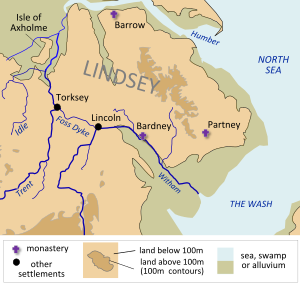Kingdom of Lindsey
Lindsey or Linnuis (Old English: Lindesege ) was one of the Anglo-Saxon kingdoms in the early medieval heptarchy . It was between the River Humber and the tidal basin The Wash on the east coast of England . Its borders were formed by the Witham and Trent rivers . There are hardly any contemporary written evidence. In the Tribal Hidage the size of Lindseys was given as 7,000 hides , which corresponded to the area of the kingdoms of Essex or Hwicce .
history
The Kingdom of Lindsey existed from the 5th to the 8th centuries. The royal dynasty seems to have established itself in a very early phase of Anglo-Saxon settlement. Presumably Lincoln , the Roman Lindum, was the capital of the kingdom, after which the Anglo-Saxons who settled there also called themselves Lindisfaras. The central sanctuary of the Lindisfarae was located in Wyham . The kingdom came under the influence of the kingdoms of Northumbria and Mercia alternately . The kings of Lindsey did not play a separate political role.
Missionary Paulinus worked in Lindsey in the 620s, when it was under the rule of Edwin of Northumbria, and established a church in Lincoln. In the middle of the 7th century, Lindsey was dominated by Penda of Mercia. In 674 Ecgfrith of Northumbria defeated King Wulfhere of Mercia and took possession of Lindsey from him. Theodore of Tarsus , Archbishop of Canterbury , raised Lindsey to an independent bishopric in 677 and Eadhæd became the first bishop. In 679 there was another battle between Ecgfrith and Æthelred of Mercia on the Trent . Following the battle, Theodore of Tarsus, the Archbishop of Canterbury, brokered a peace, after which Lindsey fell to Mercia. Beardeneu Monastery ( Bardney Abbey ) was of supraregional importance, in which Oswald of Northumbria and Æthelred of Mercia were buried.
In the late 8th century, Offa von Mercien Lindsey merged with Mercien. In 829 Egbert von Wessex conquered Mercia and its dependent territories. The last traces of Lindsey's individuality disappeared in the 9th century with the invasion of Danish Vikings . The traditional county of Lincolnshire developed from the area , the northern part of which is called Lindsey .
List of rulers
During the last years of his reign, King Offa of Mercien made a list of Lindsey's rulers, which was retained in the Anglian collection :
- Geot
- Godulf
- Finn
- Frithulf
- Frealaf
- Woden
- Winta (around 460?)
- Cretta (around 580?)
- Cueldgils (around 600?)
- Cædbæd (before 575?)
- Bubba (around 625)
- Beda (also Bedeca) (7th century)
- Biscop (7th century)
- Eanferth (Eanfrith) (around 725)
- Eatta (around 750)
- Ealdfrith (Aldfrith) (until 796).
The list is certainly very old and seems to reflect historical rulers from Winta onwards. The given periods of reign are only rough estimates. Only Ealdfrith can be determined more precisely: An, albeit controversial, Anglo-Saxon document mentions Ealdfrith in the period between 787 and 796.
swell
- anonymous: Anglo-Saxon Chronicle Online in Project Gutenberg (English)
- Beda Venerabilis : Historia ecclesiastica gentis Anglorum , Online in the Medieval Sourcebook (English)
literature
- Frank Merry Stenton: Anglo-Saxon England , Oxford University Press, Oxford 2001 (3rd ed.), ISBN 978-01928-0139-5
- Michael Lapidge, John Blair, Simon Keynes, Donald Scragg (Eds.): The Blackwell Encyclopaedia of Anglo-Saxon England. Wiley-Blackwell, Oxford et al. a. 2001, ISBN 0-631-22492-0 .
Individual evidence
- ↑ a b c d Michael Lapidge (Ed.): The Blackwell Encyclopaedia of Anglo-Saxon England , Wiley-Blackwell, 2001, ISBN 978-0-6312-2492-1 , p. 289.
- ↑ a b c d Frank Merry Stenton: Anglo-Saxon England , Oxford University Press, 2001 (3rd edition), ISBN 978-01928-0139-5 , p. 48.
- ^ A b Frank Merry Stenton: Anglo-Saxon England , Oxford University Press, 2001 (3rd ed.), ISBN 978-01928-0139-5 , pp. 115-116.
- ^ Frank Merry Stenton: Anglo-Saxon England , Oxford University Press, 2001 (3rd ed.), ISBN 978-01928-0139-5 , pp. 101-102.
- ^ A b Frank Merry Stenton: Anglo-Saxon England , Oxford University Press, 2001 (3rd ed.), ISBN 978-01928-0139-5 , p. 85.
- ^ Frank Merry Stenton: Anglo-Saxon England , Oxford University Press, 2001 (3rd ed.), ISBN 978-01928-0139-5 , p. 134.
- ↑ Anglo-Saxon Chronicle for the year 678
- ↑ Beda Venerabilis: Historia ecclesiastica gentis Anglorum 3.11
- ^ Anglo-Saxon Chronicle for the year 716
- ^ Frank Merry Stenton: Anglo-Saxon England , Oxford University Press, 2001 (3rd edition), ISBN 978-01928-0139-5 , pp. 231-232.
- ↑ The list is based on: Frank Merry Stenton (Author), Doris Mary Stenton (Ed.): Preparatory to Anglo-Saxon England: Being the Collected Papers of Frank Merry Stenton (Oxford Scholarly Classics), Oxford University Press, 2001, ISBN 978 -0198223146 , pp. 127-128.
- ↑ Frank Merry Stenton (author), Doris Mary Stenton (ed.): Preparatory to Anglo-Saxon England: Being the Collected Papers of Frank Merry Stenton (Oxford Scholarly Classics), Oxford University Press, 2001, ISBN 978-0198223146 , p. 131-132.
- ^ P. 1183

